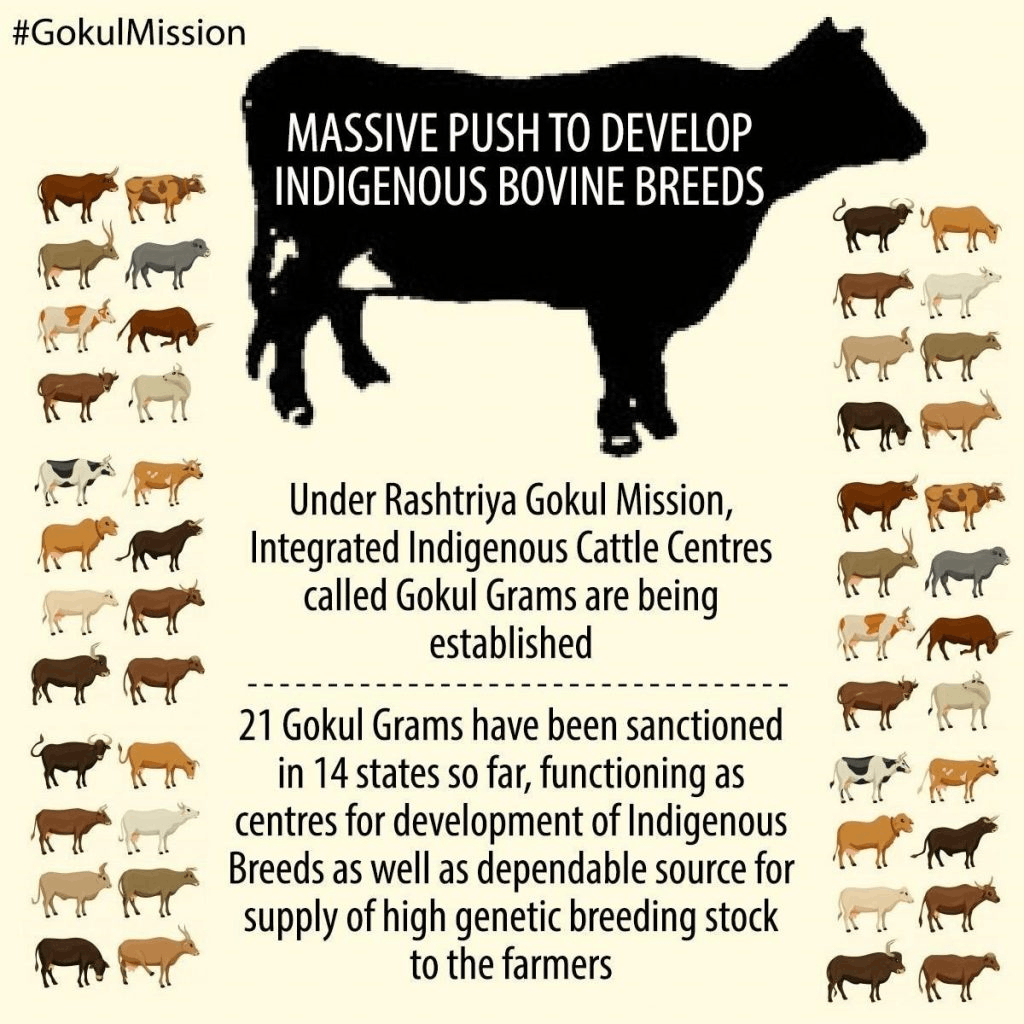Ahmedabad
(Head Office)Address : 506, 3rd EYE THREE (III), Opp. Induben Khakhrawala, Girish Cold Drink Cross Road, CG Road, Navrangpura, Ahmedabad, 380009.
Mobile : 8469231587 / 9586028957
Telephone : 079-40098991
E-mail: dics.upsc@gmail.com

Rashtriya Gokul Mission
Context: It’s been a decade since the Rashtriya Gokul Mission was launched and studies have shown that instead of improving the quality of all the indigenous breeds, as envisioned under the scheme, it has ended up promoting only one indigenous variety, the Gir cow, across the country.
What is The Rashtriya Gokul Mission?
• The Rashtriya Gokul Mission, rolled out in December 2014, has two major components: research and development of highquality semen to increase the chances of female calf births and the setting up of semen stations to ensure easy access to highquality semen for livestock rearers across the country.
Concerns with mission:
• The initiative was started with the idea that research will be carried out on a host of high milk-yielding indigenous bovine varieties such as Sahiwal, Tharparkar, Red Sindhi. However, all states are demanding Gir varieties for carrying out artificial insemination.
• The 2019 livestock census showed a 70% increase in purebred Gir cows since 2013. In contrast, other indigenous breeds like Sahiwal and Hariana have not experienced similar growth, with some even witnessing a decline in numbers. This trend raises concerns about the loss of diversity in indigenous cattle breeds in India.
What are the concerns with Gir Cow Breed?
• Contrary to the growing obsession with Gir cows, research reveals that graded Gir cows do not consistently outperform indigenous breeds in many states. For example, in Haryana, there is no evidence of increased milk production in graded Gir cows.
• The performance of graded Gir cows is influenced by factors beyond their adaptability to microclimatic conditions. For instance, Gir cows thrive in herds, and their milk production decreases when raised in isolation.
• Without adequate resources and support, these cows can become a liability for farmers. This was evident in a previous case in Vidarbha.
Solutions:
• Experts suggest a shift from the current focus on a few high-yielding bovine varieties to identifying and breeding genetically superior cows from among indigenous breeds.
• Experts caution against repeating the mistakes of the White Revolution, which imported exotic breeds likeJersey for crossbreeding with Indian varieties. While this increased milk production, it did not necessarily lead to higher income for livestock rearers, as crossbred cows were more susceptible to diseases and required more care.
Government of India initiatives:
• National Animal Disease Control Programme
• National Artificial Insemination Programme
• Animal Husbandry Infrastructure Development Fund
• National Kamdhenu Breeding Centre
• Gokul Grams

Address : 506, 3rd EYE THREE (III), Opp. Induben Khakhrawala, Girish Cold Drink Cross Road, CG Road, Navrangpura, Ahmedabad, 380009.
Mobile : 8469231587 / 9586028957
Telephone : 079-40098991
E-mail: dics.upsc@gmail.com
Address: A-306, The Landmark, Urjanagar-1, Opp. Spicy Street, Kudasan – Por Road, Kudasan, Gandhinagar – 382421
Mobile : 9723832444 / 9723932444
E-mail: dics.gnagar@gmail.com
Address: 2nd Floor, 9 Shivali Society, L&T Circle, opp. Ratri Bazar, Karelibaugh, Vadodara, 390018
Mobile : 9725692037 / 9725692054
E-mail: dics.vadodara@gmail.com
Address: 403, Raj Victoria, Opp. Pal Walkway, Near Galaxy Circle, Pal, Surat-394510
Mobile : 8401031583 / 8401031587
E-mail: dics.surat@gmail.com
Address: 303,305 K 158 Complex Above Magson, Sindhubhavan Road Ahmedabad-380059
Mobile : 9974751177 / 8469231587
E-mail: dicssbr@gmail.com
Address: 57/17, 2nd Floor, Old Rajinder Nagar Market, Bada Bazaar Marg, Delhi-60
Mobile : 9104830862 / 9104830865
E-mail: dics.newdelhi@gmail.com